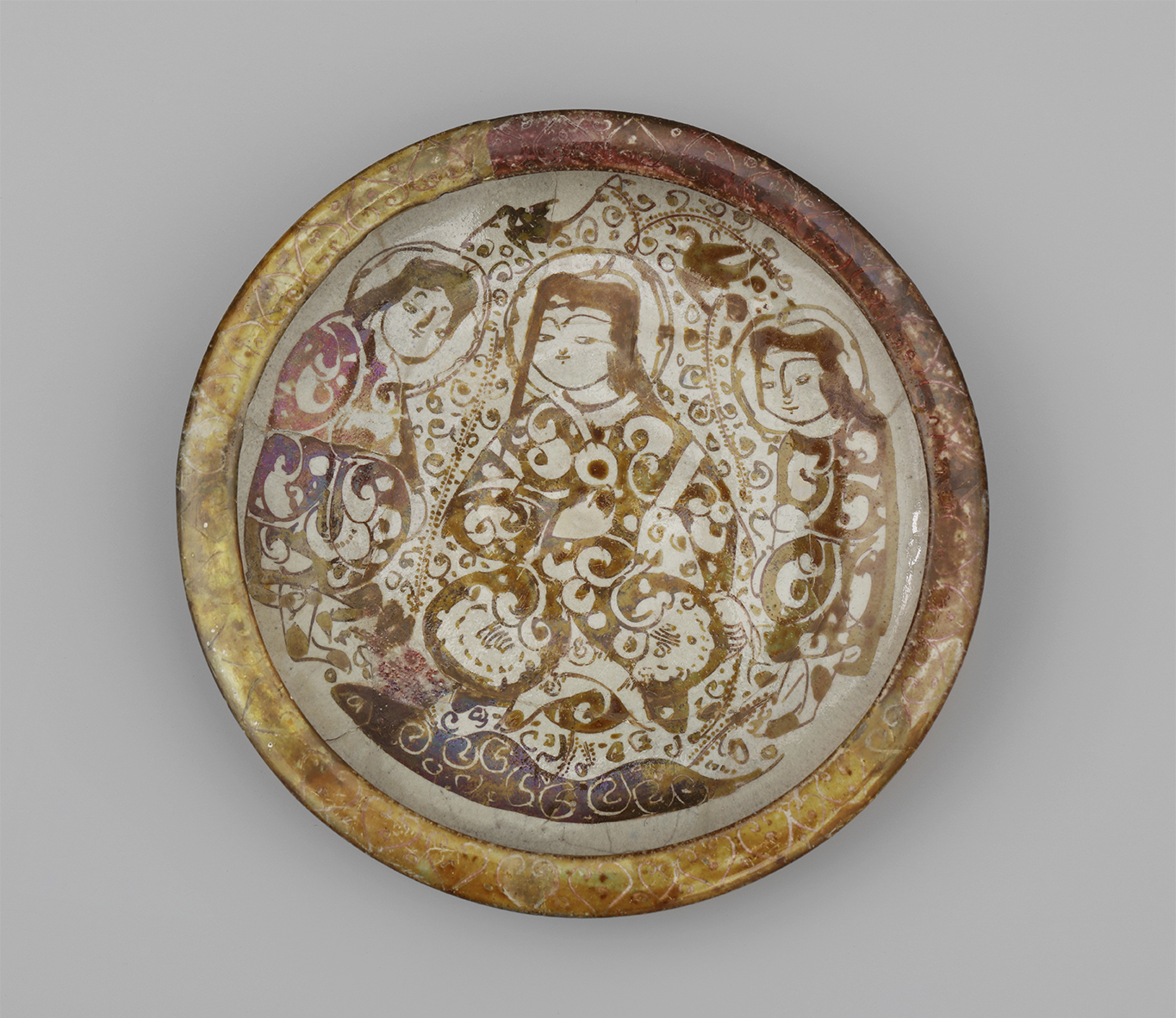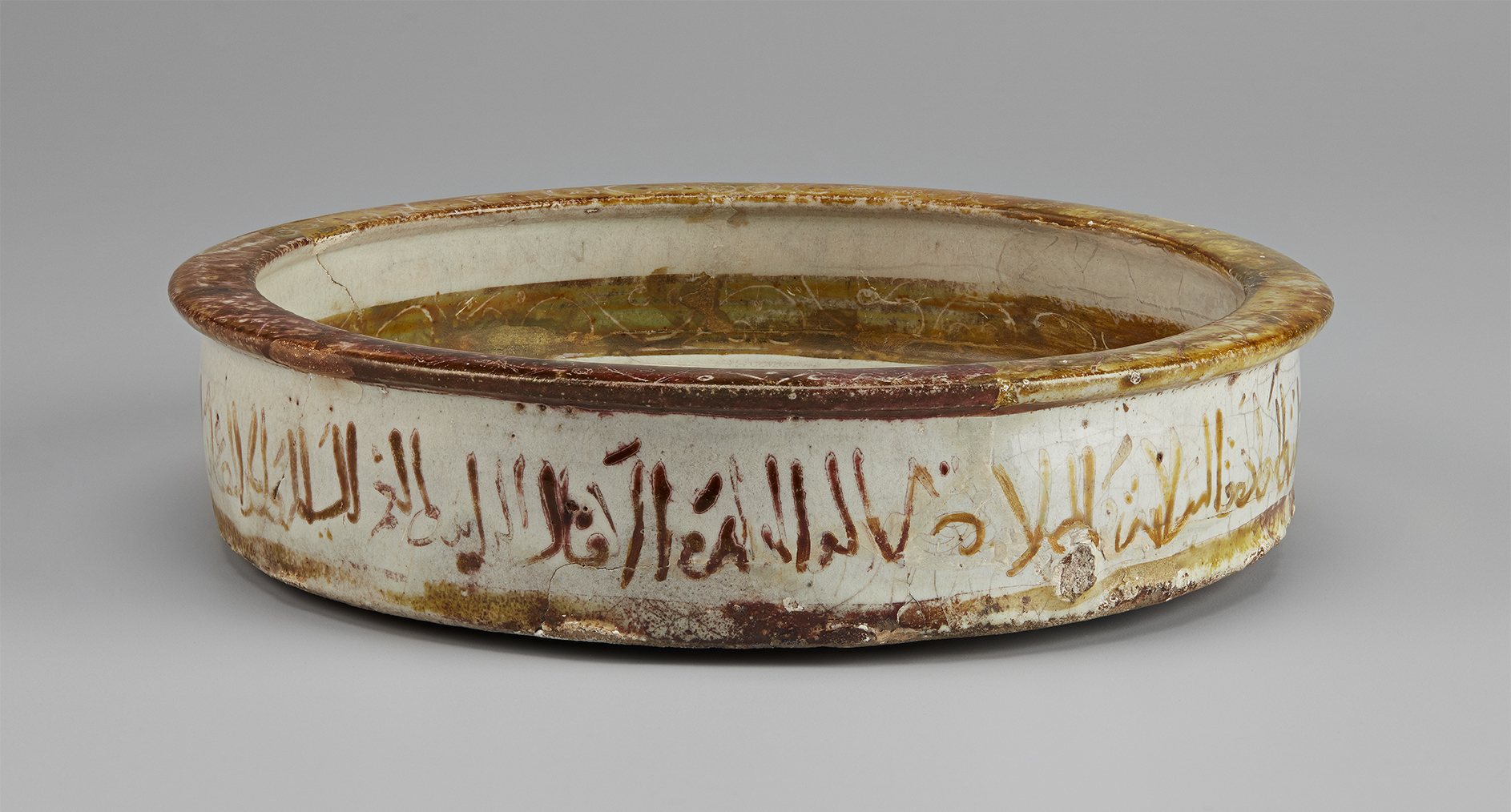Click on the image to zoom
Lustre-Painted Dish
- Accession Number:AKM559
- Place:Iran, Kashan
- Dimensions:diameter: 17 cm
- Date:12th–13th century
- Materials and Technique:fritware, lustre painted
This small lustre-painted bowl was produced in Kashan, a city in central Iran known for its ceramic production between the 11th and 13th centuries. Kashan ceramics were made of fritware, a mixture of minerals (namely glass and clay).[1] They were painted over with lustre, which gives the ceramic surface a bright, metallic gleam.[2] Due to its flat base and wide rim, the shape of this bowl in the Aga Khan Museum Collection echoes the design of a metal vessel. The lustre also suggests the sheen of gold.
Further Reading
Kashan fritware often depicted scenes of elite leisure activities such as hunting, feasting, and dancing.[3] This bowl is no exception: its interior features a seated female figure accompanied by two attendants on either side. She is holding a cup in her left hand, and the scene is set against a background of scrolling vines and flying birds, perhaps invoking a garden space. This scene may allude to a social gathering during which attendees would enjoy courtly pursuits, such as partaking in a feast, perhaps accompanied by a musical performance or a poetry recitation.
Such activities constituted one component of the medieval Persian conception of courtly enjoyment, called “feasting and fighting” or bazm wa razm.[4] Representations of this concept often included images of figures on horseback (see AKM555) as well as illustrations of feasts featuring seated figures holding cups or other vessels (see AKM763). Similar iconography can also be found on various media from the same period, such as the paintings in copies of the Shahnameh (Book of Kings), one of the most popular illustrated manuscripts in late medieval and early modern Iran.[5]
On the exterior rim of this bowl is an inscription in naskh, or cursive script, painted in lustre over the white ceramic surface. Although the inscription is illegible, it may have followed the tradition of other Kashan wares by offering blessings to the object’s owner. These blessings may have been repeated invocations for happiness and safety (see AKM794), or poetic excerpts, such as the verses included on a dish [6] at the Metropolitan Museum of Art, in New York.
Lustre painting first emerged in Iraq in the 9th century.[7] Used for ceramic decoration, lustre paint was made by compounding metal oxides to create bright yellows and browns. Before the paints’ application, the vessel in question would have already gone through the process of a first firing, through which the ceramic body was hardened.[8] The lustre would have then been applied, followed by a second firing to fix the colour onto the ceramic surface.[9]
In the 12th and 13th centuries, this particular method of ceramic production and painting was introduced to cities in Iran, such as Rayy, and Kashan, where this dish in the Aga Khan Museum Collection is thought to have been produced.[10] The painted composition on this bowl is achieved by selectively applying lustre to demarcate the outlines of the seated figures at the centre, as well as the undulating lines of the vegetal motifs and the inscription on the outer edge. The remaining sections of the vessel are left blank, exposing the white fritware surface.
The three figures’ rounded facial features (including their almond-shaped eyes and arched, narrow eyebrows) are common to a genre of portraiture referred to as “moon-face” (mah-ruy), which was considered to embody the epitome of beauty.[11] Often linked to literature, depictions of “moon-faced” figures abound in medieval Persian art, including illustrated manuscripts, ceramics, and metalwork.[12] The ability of this lustre-painted dish to catch and reflect light may also allude to the moon’s light-emitting properties.[13]
— Michelle al-Ferzly
Notes
[1] For a more detailed discussion of the recipes used to create fritware, see Allan, “Abū’l Qasim’s Treatise on Ceramics,” 113–14.
[2] Watson, Ceramics from Islamic Lands, 114.
[3] Ibid., Persian Lustre Ware, 45.
[4] Canby et al, Court and Cosmos, 59. With regards to bazm wa razm, see also a 2015 exhibition on the subject at the Metropolitan Museum of Art, https://www.metmuseum.org/exhibitions/listings/2015/bazm-and-razm.
[5] Sims et al, Peerless Images, 91-126; Canby, The Shahnama of Shah Tahmasp, 21–4; 50.
[6] Metropolitan Museum of Art, 32.52.2, https://www.metmuseum.org/art/collection/search/448672.
[7] Grube, “The Art of Islamic Pottery,” 211.
[8] Allan, “Abū’l Qasim’s Treatise on Ceramics,” 114–5; 119–20.
[9] Ibid.
[10] Grube, “The Art of Islamic Pottery,” 215.
[11] Melikian-Chirvani, Le monde iranien et l’Islam, 38; Junod and Graves, Treasures of the Aga Khan Museum, 279.
[12] Kim et al., Pattern and Light, 50.
[13] Gruber, The Moon, 176–77.
References
Allan, James. “Abū’l Qasim’s Treatise on Ceramics.” Iran 11 (1973): 111–20. DOI: 10.2307/4300488
Canby, Sheila R. The Shahnama of Shah Tahmasp: The Persian Book of Kings. New Haven: Yale University Press, 2014. ISBN: 9780300194548
---, Deniz Beyazit, Martina Rugiadi, and A.C.S Peacock. Court and Cosmos: The Great Age of the Seljuks. New York: Metropolitan Museum of Art, 2016. ISBN: 9781588395894
Grube, Ernst. “The Art of Islamic Pottery.” The Metropolitan Museum of Art Bulletin 23.6 (1965): 209–28. DOI: 10.2307/3257942
Gruber, Christiane, ed. The Moon: A Voyage Through Time. Toronto, ON: Aga Khan Museum, 2019. ISBN: 9781926473154
Junod, Benoît, and Margaret Graves, ed. Treasures of the Aga Khan Museum: Arts of the Book and Calligraphy. Istanbul: Sabancı Üniversitesi - Sakıp Sabancı Müzesi, 2010. ISBN: 9786054348084
Kim, Henry S. Pattern and Light: Aga Khan Museum. New York, NY: Skira Rizzoli; Toronto: Aga Khan Museum, 2014. ISBN: 9780847844296
Melikian-Chirvani, A.S. Le monde iranien et l’Islam: sociétés et cultures II. Geneve: Librarie Droz, 1974.
Schimmel, Annemarie. As Through a Veil: Mystical Poetry in Islam. Oxford: Oneworld, 2001. ISBN: 9781851682744
Sims, Eleanor, Boris I. Marshak, and Ernst Grube. Peerless Images: Persian Painting and its Sources. New Haven and London: Yale University Press, 2002. ISBN: 9780300090383
Watson, Oliver. Ceramics from Islamic Lands. London: Thames & Hudson, 2006. ISBN: 9780500976340
Ibid., Persian Lustre Ware. London: Faber & Faber, 1985. ISBN: 9780571132355
Note: This online resource is reviewed and updated on an ongoing basis. We are committed to improving this information and will revise and update knowledge about this object as it becomes available.








